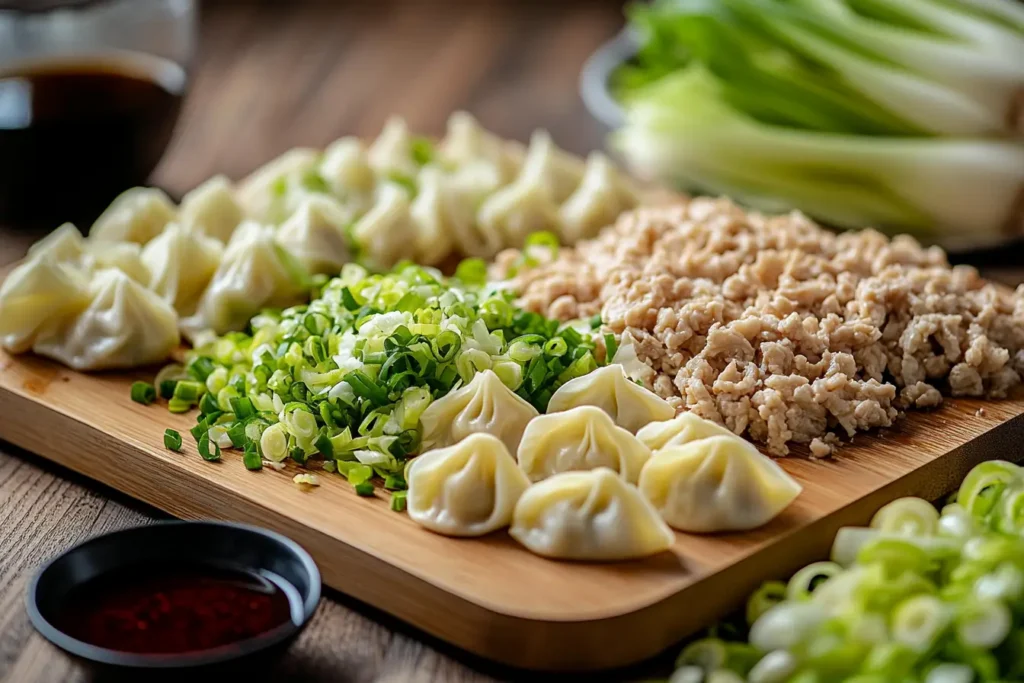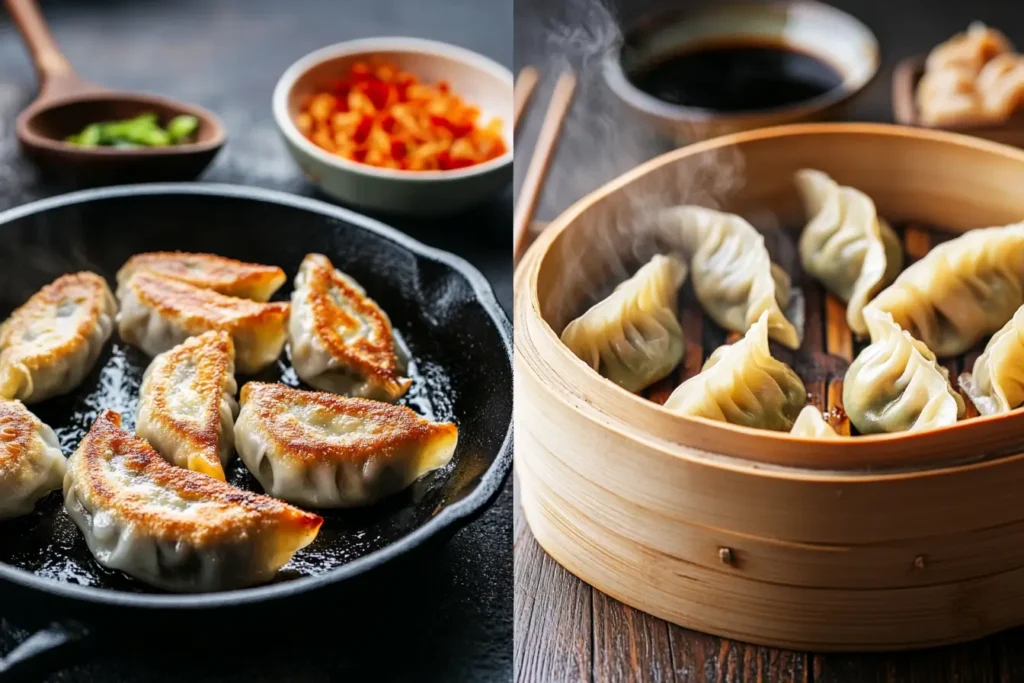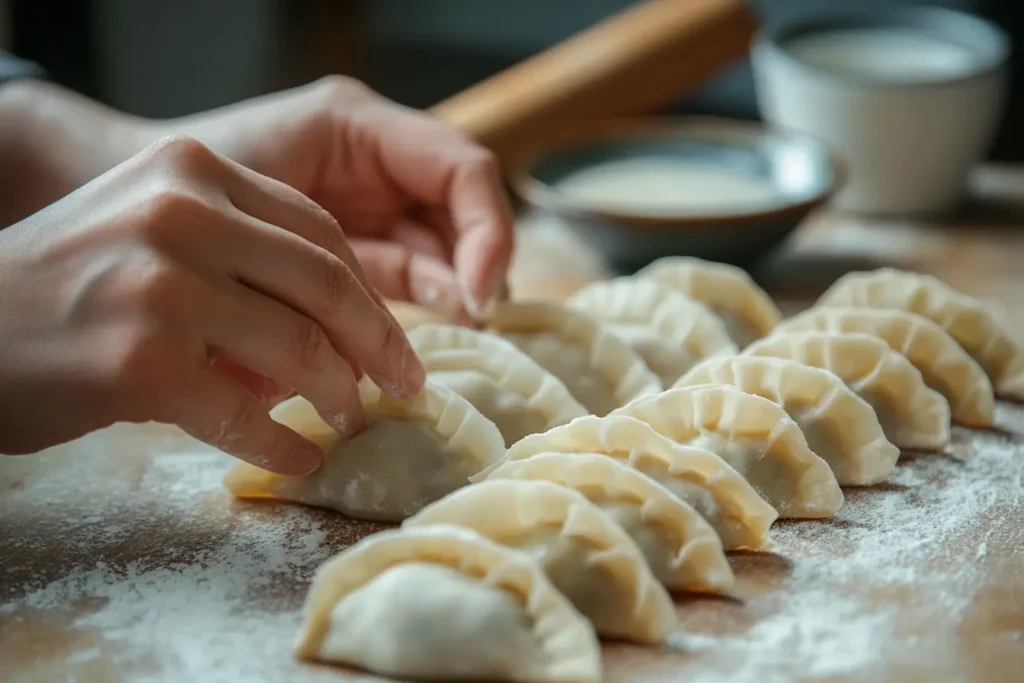Dumplings are a global comfort food, found in cuisines from China to Italy, from Japan to Poland. Among the many variations, gyoza—a Japanese take on the classic Chinese dumpling—stands out for its distinct taste, texture, and preparation method. But what is the difference between gyoza and dumplings? While both share a similar base concept, they have notable differences in origin, ingredients, cooking styles, and even cultural significance.
This article will break down everything you need to know about gyoza and dumplings, comparing their history, fillings, wrappers, cooking techniques, and nutritional differences. Whether you’re a foodie looking to expand your culinary knowledge or just someone craving dumplings, this guide will give you a deep dive into the delicious world of gyoza and dumplings.
Let’s begin by understanding what each one actually is.
Table of Contents
Introduction to Dumplings and Gyoza
Defining Dumplings
At its core, a dumpling is a broad term for small pieces of dough that may be filled with meat, vegetables, or even sweet ingredients. Dumplings are found in countless global cuisines—jiaozi in China, pierogi in Poland, momo in Nepal, and ravioli in Italy. While their fillings, wrappers, and cooking methods vary widely, dumplings generally have a chewy or tender dough exterior that encases a flavorful filling.
Chinese dumplings, or jiaozi, are among the most well-known types. Typically made with a wheat flour wrapper, they can be boiled (shuijiao), steamed (zhengjiao), or pan-fried (guotie), which are commonly known as potstickers.
What is Gyoza?
Gyoza is Japan’s beloved version of the dumpling, directly inspired by Chinese jiaozi. Japanese soldiers who occupied Manchuria during World War II were introduced to jiaozi and, upon returning home, adapted the recipe to suit Japanese tastes. This led to the creation of gyoza, a dumpling with a thinner wrapper and a more finely minced filling, giving it a delicate yet crispy texture when cooked.
Unlike Chinese dumplings, gyoza is most commonly pan-fried (yaki gyoza), resulting in a crispy-bottomed, golden-brown dumpling with a juicy, flavorful center. Other variations include sui gyoza (boiled gyoza) and age gyoza (deep-fried gyoza), but pan-frying remains the most popular method in Japan.
Why Compare Gyoza and Dumplings?
Many people assume that gyoza and dumplings are interchangeable, but their subtle differences in ingredients, cooking techniques, and flavor profiles set them apart. Understanding these distinctions helps food lovers appreciate the nuances of both dishes and choose the right type for their cravings.
So, what truly separates gyoza from dumplings? In the next section, we’ll explore the fascinating history behind these iconic dishes.
History and Origins
The Ancient Roots of Dumplings
Dumplings have been a staple in many cultures for centuries, but their origins trace back to China. Jiaozi, the Chinese dumpling, is believed to have been created over 1,800 years ago during the Eastern Han Dynasty. A physician named Zhang Zhongjing reportedly invented them as a remedy for frostbite, stuffing lamb and herbs into dough wrappers before boiling them.
Over time, dumplings became an essential part of Chinese cuisine, particularly during the Lunar New Year, where they symbolize wealth and prosperity. From China, they spread to other Asian countries and even to Europe, leading to variations like Polish pierogi and Italian ravioli.
How Gyoza Evolved from Chinese Dumplings
So, what is the difference between gyoza and dumplings in terms of history? Unlike traditional dumplings, gyoza has a much more recent origin. Japanese soldiers stationed in Manchuria during World War II became familiar with jiaozi and developed a craving for them upon returning home. However, instead of simply copying the Chinese recipe, they modified it to fit Japanese culinary preferences.
The result? Gyoza, a dumpling with a thinner wrapper, a more finely minced filling, and a crispier texture. The Japanese favored pan-frying (yaki gyoza) over boiling, giving it a golden-brown, slightly crunchy exterior while keeping the inside juicy and flavorful.
Modern-Day Popularity
Today, dumplings and gyoza have both become global sensations. In China, jiaozi remains a must-have dish for special occasions, while gyoza is a favorite snack in Japanese ramen shops and izakayas.
Beyond Asia, dumplings of all kinds have gained popularity in Western countries, where they are often served in fusion dishes or as quick, delicious appetizers. Whether pan-fried, steamed, or boiled, both gyoza and dumplings continue to evolve while staying true to their rich history.
Ingredients and Filling Differences

Dumpling Ingredients Across Different Cultures
Dumplings come in countless varieties, with different fillings, wrappers, and seasonings depending on the country. Chinese jiaozi typically use a wheat flour-based wrapper filled with minced pork, cabbage, scallions, and garlic. Some variations include shrimp, chicken, or vegetarian fillings, with flavors enhanced by ginger and soy sauce.
Other Asian dumplings, like Korean mandu and Nepalese momo, incorporate different spices and proteins, giving them their own unique twists. European dumplings like Polish pierogi often feature potato and cheese fillings, while Italian ravioli use pasta dough with ricotta or meat fillings.
What’s Inside a Gyoza?
Unlike traditional dumplings, gyoza has a distinctly Japanese flavor profile. The filling is typically made with ground pork, garlic, ginger, chives, and cabbage, but the ingredients are finely minced to create a smoother texture. This allows for a juicier, more delicate bite.
Additionally, gyoza often contains a bit more garlic than Chinese jiaozi, giving it a slightly bolder taste. Some modern variations even feature unique fillings like cheese, seafood, or spicy miso for an added twist.
Wrapper Thickness and Texture Differences
One of the biggest differences between gyoza and dumplings lies in the wrapper. Traditional Chinese dumplings tend to have a thicker, chewier dough, making them ideal for boiling or steaming. The dough needs to be sturdy enough to hold its shape and withstand long cooking times.
On the other hand, gyoza wrappers are thinner and more delicate, making them crispier when pan-fried. This thinness also allows them to cook quickly, resulting in a contrast between the crispy bottom and the soft, juicy filling inside.
If you’re looking to make dumplings at home and wondering if you can use wonton wrappers, check out this guide: Can I Use Wonton Wrappers for Dumplings?.
Cooking Methods and Texture

Different Ways to Cook Dumplings
Dumplings are incredibly versatile, and their cooking method significantly affects their taste and texture. Depending on the preparation, dumplings can be:
- Boiled (shuijiao) – Soft and chewy, these are cooked in water or broth until tender.
- Steamed (zhengjiao) – Light and delicate, these retain moisture and absorb flavors well.
- Pan-Fried (guotie) – Also called potstickers, these have a crispy bottom with a soft, juicy filling.
- Deep-Fried (zha jiaozi) – Crunchy and golden, these are popular as a snack or appetizer.
Chinese dumplings (jiaozi) are commonly boiled or steamed, making them chewy and soft. On the other hand, pan-fried dumplings are widely loved for their crispy bottoms and slightly chewy tops.
Gyoza’s Signature Cooking Style
What is the difference between gyoza and dumplings when it comes to cooking? The biggest distinction lies in how they are prepared.
Japanese gyoza is almost always pan-fried, a method that creates a crispy, golden-brown bottom while keeping the inside juicy and flavorful. This technique, called yaki gyoza, involves frying the dumplings in a small amount of oil, then adding water and covering the pan to allow them to steam. Once the water evaporates, the gyoza are crisped up again for a final touch.
Other variations include:
- Boiled (sui gyoza) – A softer, silkier version served in soup.
- Deep-Fried (age gyoza) – A crunchier, crispier take, similar to spring rolls.
Because of their thinner wrappers, gyoza crisps up more easily, giving them a lighter texture compared to the denser chew of traditional dumplings.
How Cooking Affects Taste and Texture
Cooking methods change not just the texture but also the flavor of dumplings. Boiled dumplings tend to be soft and absorb the flavors of soups or dipping sauces. Steamed dumplings have a light and airy texture, allowing the fillings to shine. Fried dumplings, including gyoza, offer a satisfying contrast between the crispy wrapper and juicy interior.
So, if you love crispy textures and bold flavors, gyoza might be your go-to choice. But if you prefer something soft and comforting, traditional Chinese dumplings may be the better option.
For more delicious dumpling variations, check out this guide: Can I Use Wonton Wrappers for Dumplings?.
Regional Variations and Cultural Significance
Chinese Dumpling Varieties
Dumplings are a key part of Chinese cuisine, and they come in various forms:
- Jiaozi – The classic Chinese dumpling, filled with pork, vegetables, or shrimp.
- Xiaolongbao – Soup dumplings with a thin skin and a juicy, broth-filled center.
- Shumai – Open-top steamed dumplings, often filled with shrimp or pork.
- Har Gow – Delicate shrimp dumplings wrapped in a translucent rice wrapper.
Chinese dumplings are not just everyday food—they hold deep cultural significance, especially during Chinese New Year. Families gather to make dumplings together, as they symbolize prosperity and good fortune.
Japanese Gyoza Variations
Although gyoza was inspired by Chinese jiaozi, Japan has developed its own distinct versions:
- Yaki Gyoza – The classic pan-fried style with a crispy bottom.
- Sui Gyoza – A boiled version, often served in a light broth.
- Age Gyoza – Deep-fried for extra crunch.
Unlike Chinese dumplings, which are often eaten plain or dipped in vinegar, gyoza is commonly paired with a tangy dipping sauce made of soy sauce, rice vinegar, and chili oil. Gyoza is also a popular side dish in ramen shops and izakayas (Japanese pubs), making it a staple of casual dining in Japan.
Symbolism and Festive Importance
Dumplings in China are often associated with family gatherings and celebrations, particularly during New Year’s Eve. The shape of a dumpling resembles ancient Chinese gold ingots, symbolizing wealth and prosperity.
In Japan, gyoza does not hold the same deep-rooted symbolism, but it is a beloved comfort food. Whether eaten at home, in ramen shops, or at izakayas, gyoza is a casual yet essential part of Japanese cuisine.
Both dishes may have different cultural roles, but their appeal remains universal. No matter where you are, a plate of dumplings—whether Chinese jiaozi or Japanese gyoza—is always a treat.
Nutritional Differences and Dietary Considerations
Caloric and Nutritional Breakdown
When comparing gyoza and dumplings, many people wonder which is the healthier option. The answer depends on factors like ingredients, cooking method, and portion size.
Generally, dumplings (jiaozi) have a slightly higher calorie count due to their thicker wrappers, which contain more carbohydrates. A typical boiled Chinese dumpling has around 40-50 calories per piece, while a pan-fried dumpling can go up to 80 calories.
Gyoza, with its thinner wrapper, is slightly lower in carbs but higher in fat because it’s almost always pan-fried. A standard gyoza contains about 60-80 calories, depending on the filling. The crispy texture may make it more tempting, leading to larger portions being eaten in one sitting.
If you’re watching your calorie intake, opting for boiled dumplings or sui gyoza (boiled gyoza) can be a lighter choice.
Healthier Options and Dietary Adaptations
For those with dietary restrictions, there are many ways to modify dumplings and gyoza to suit different needs:
- Gluten-Free Options – Traditional wheat-based wrappers can be swapped for rice paper or gluten-free flour.
- Vegan and Vegetarian Versions – Instead of pork or shrimp, fillings can include tofu, mushrooms, and vegetables. If you’re looking for a gelatin-free version of soup dumplings, check out alternatives like agar-agar.
- Low-Calorie Choices – Boiling or steaming instead of frying reduces fat content. Using lean proteins and extra vegetables can also help.
What is the difference between gyoza and dumplings nutritionally? While both can be part of a balanced diet, Chinese dumplings tend to have more variety in cooking methods, allowing for healthier options. Meanwhile, gyoza is often higher in fat due to its signature crispy texture.
How to Make Gyoza and Dumplings at Home

Step-by-Step Gyoza Recipe
Making homemade gyoza is easier than you might think! Here’s a simple recipe to try:
Ingredients:
- 1 pack of thin dumpling wrappers (gyoza wrappers)
- ½ pound ground pork or chicken
- 1 cup finely chopped cabbage
- 2 cloves garlic, minced
- 1 teaspoon grated ginger
- 2 tablespoons soy sauce
- 1 teaspoon sesame oil
- ½ teaspoon salt
- ½ teaspoon pepper
- 2 tablespoons vegetable oil
- ¼ cup water
Instructions:
- Prepare the Filling: In a bowl, mix the ground meat, cabbage, garlic, ginger, soy sauce, sesame oil, salt, and pepper.
- Assemble the Gyoza: Place a teaspoon of filling in the center of a wrapper. Moisten the edges with water and fold in half, pleating the edges for a tight seal.
- Pan-Fry the Gyoza: Heat oil in a non-stick pan over medium heat. Place the gyoza flat-side down and cook until golden brown (about 2 minutes).
- Steam the Gyoza: Add ¼ cup of water, cover, and let steam for 5 minutes until fully cooked. Uncover and let the remaining water evaporate.
- Serve: Enjoy with a dipping sauce made of soy sauce, rice vinegar, and a dash of chili oil!
Step-by-Step Dumpling Recipe
Chinese dumplings (jiaozi) follow a similar process but use a thicker wrapper and have more diverse cooking methods.
Ingredients:
- 1 pack of dumpling wrappers (jiaozi wrappers)
- ½ pound ground pork or chicken
- 1 cup chopped Napa cabbage
- 1 teaspoon minced garlic
- 1 teaspoon grated ginger
- 2 tablespoons soy sauce
- 1 teaspoon sesame oil
- 1 teaspoon cornstarch
- ½ teaspoon salt
- ½ teaspoon pepper
Instructions:
- Make the Filling: Mix all ingredients in a large bowl.
- Assemble the Dumplings: Place filling in each wrapper, seal the edges with water, and fold into a crescent shape.
- Cooking Methods:
- Boiled: Cook in boiling water for 4-5 minutes.
- Steamed: Place in a bamboo steamer and steam for 8-10 minutes.
- Pan-Fried: Follow the same steps as gyoza for crispy dumplings.
- Serve and Enjoy: Dip in soy sauce, vinegar, or chili oil!
Common Mistakes to Avoid
- Overfilling the wrapper – This makes sealing difficult and can cause dumplings to burst.
- Not sealing properly – If the edges aren’t sealed well, the filling may leak out.
- Skipping the steaming step in pan-frying – This ensures the filling cooks fully.
Now that you know how to make both dishes, which one will you try first? If you love the crispy texture of gyoza, go for pan-frying. If you prefer something softer, steamed or boiled dumplings might be a better fit!
FAQs
Many people have questions about dumplings and gyoza, especially when it comes to substitutions, cooking methods, and dietary options.
What is a substitute for gelatin in soup dumplings?
Traditional soup dumplings (xiaolongbao) use gelatin to solidify the broth, which melts when steamed. If you’re looking for a substitute, you can use agar-agar, a plant-based gelling agent. It works similarly to gelatin but is completely vegan-friendly. Another option is cornstarch-thickened broth, though it won’t create the same solid-to-liquid transformation as gelatin.
Is there a vegan substitute for gelatin?
Yes! If you want to make soup dumplings without gelatin, agar-agar or kudzu starch are excellent alternatives. These ingredients set liquid into a jelly-like consistency, allowing you to achieve a similar effect without using animal-based products.
Can I use wonton wrappers for dumplings?
Yes, but with some limitations. Wonton wrappers are thinner and lack the elasticity of dumpling wrappers, which can make folding trickier. If you plan to boil or steam your dumplings, you may find that wonton wrappers become too soft or tear easily. However, they work well for pan-fried dumplings or potstickers.
What is the difference between gyoza and dumplings?
The biggest difference is in the wrapper thickness, texture, and cooking method. Chinese dumplings (jiaozi) have a thicker, chewier wrapper and can be boiled, steamed, or pan-fried. Japanese gyoza has a thinner wrapper and is almost always pan-fried, giving it a crispier bite.
Additionally, gyoza fillings are usually more finely minced and contain more garlic, whereas dumpling fillings vary widely based on the region.
Conclusion
So, what is the difference between gyoza and dumplings? While both belong to the same dumpling family, their flavors, textures, and cooking methods set them apart. Chinese dumplings (jiaozi) are hearty and chewy, perfect for boiling or steaming. Meanwhile, gyoza offers a lighter, crispier bite with its signature pan-fried finish.
Ultimately, whether you prefer the juicy crunch of gyoza or the comforting softness of boiled dumplings, there’s no wrong choice. Both are delicious, versatile, and deeply rooted in cultural traditions.
If you’ve never made dumplings before, why not try both? Experiment with different fillings, cooking styles, and dipping sauces to find your favorite. No matter how you enjoy them, one thing is certain—gyoza and dumplings are timeless dishes that will never go out of style.
Craving more cooking tips? Explore our guides on dumpling techniques and ingredient swaps to level up your homemade creations!
Dernière mise à jour : 31 January 2025

